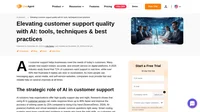The effectiveness of customer support can make or break a business. With the right knowledge base software, companies can streamline their support processes and empower users with self-service information.
A SaaS (Software as a Service) knowledge base is a centralized repository that provides users with easy access to valuable information, helping them resolve issues independently. When properly implemented, it enhances customer satisfaction and reduces support costs.
This article explores the 10 best SaaS knowledge base platforms, offering a comprehensive review and practical examples. Join us as we dive into the features, benefits, and insights for choosing the right platform for your needs.
Table of Contents
- What is the knowledge base for SaaS
- Key features of effective knowledge base platforms
- Benefits of implementing a knowledge base in SaaS
- LiveAgent
- Helpjuice
- Zendesk Guide
- Knowledgebase.com
- HubSpot Knowledge Base
- Freshdesk
- Document360
- Knowmax
- Bloomfire
- ServiceNow Knowledge Management
- Practical insights for choosing the right knowledge base software
- 5 SaaS knowledge base examples: Learning from the best
- What should you include in your SaaS knowledge base?
- Why invest in a SaaS knowledge base, and what is the ROI?
- Conclusion
What is the knowledge base for SaaS
A SaaS knowledge base is a cloud-hosted resource center that enables companies to create, manage, and share information readily accessible online. It acts as a central repository organizing valuable content such as articles, guides, tutorials, and FAQs related to a company’s products or services. This platform empowers both customers and employees to find solutions on their own, improving the overall customer experience.
One of the key advantages of a SaaS knowledge base is its accessibility. As long as there is an internet connection, users can access a wealth of information anywhere, which is not possible with some self-hosted solutions that require users to be in a specific location.
Businesses benefit from SaaS knowledge bases by increasing customer satisfaction while reducing costs. By offering consistent and efficient solutions to common questions and issues, companies can decrease the workload on their customer support team and streamline operations.
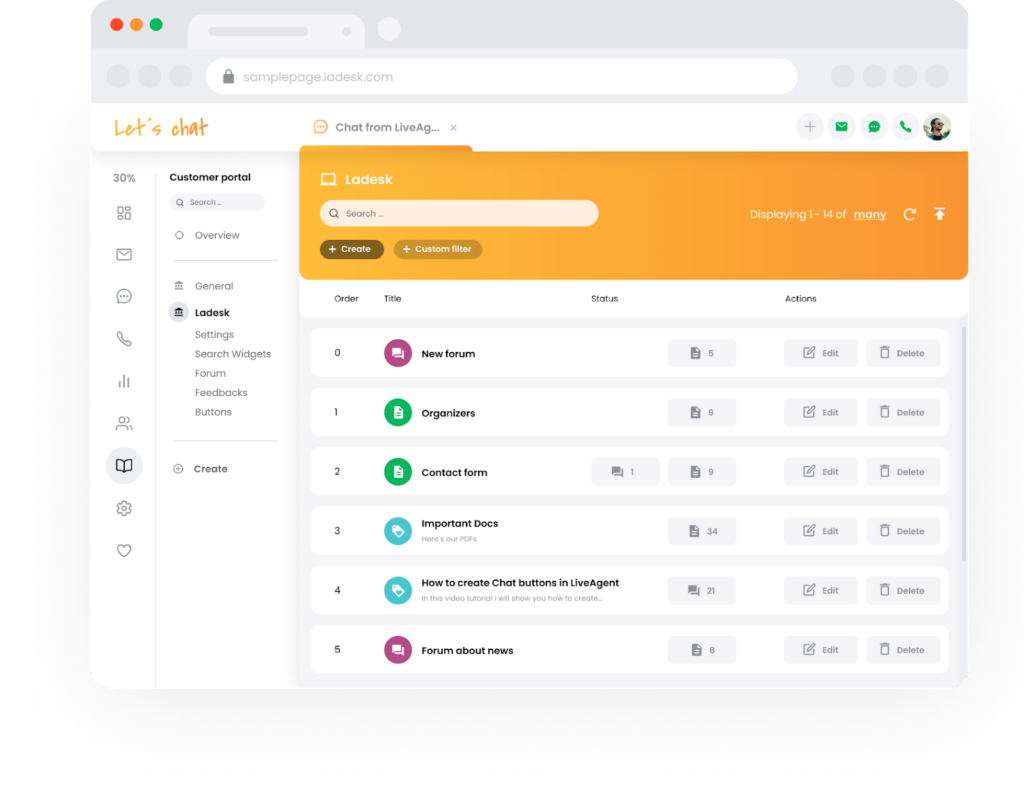
Common features that make SaaS knowledge bases effective include prominent search bars, interactive guides, and easy-to-find troubleshooting guides. These elements ensure that users can quickly find relevant articles and information they need.
Overall, SaaS knowledge bases are essential for handling customer support queries effectively and maintaining a high level of knowledge management.
Key features of effective knowledge base platforms
Effective knowledge base platforms serve as a repository of information for users to resolve issues through self-service resources. Security plays a crucial role, ensuring only authorized users can access sensitive data. User-friendly navigation, with categories, filters, and content tags, helps users find information quickly.
Integration with web and in-app widgets allows users to access support seamlessly from websites or applications. This instant access enhances the user experience and customer satisfaction.
Content analytics tools are vital for ongoing knowledge base management. They track user interactions, article popularity, and time spent on pages. This data helps continuously improve and update the knowledge base content.
Key features:
- Security settings and access permissions
- User-friendly navigation
- Web and in-app widget integration
- Content analytics tools
Using these features effectively can significantly improve customer experience and satisfaction.
Benefits of implementing a knowledge base in SaaS
Implementing a knowledge base in SaaS brings numerous benefits. First, it enhances customer experience by providing quick access to information. This allows users to solve issues independently without contacting support. As a result, businesses see a significant reduction in support costs. Self-service solutions for common questions free up the customer support team for more complex issues.
A comprehensive knowledge base also increases customer retention. When users easily find answers, satisfaction, and engagement grow. This is crucial for customer success and building long-term relationships. Additionally, it improves the onboarding process for new users. By offering easily accessible resources and documentation, users can integrate seamlessly into the system.
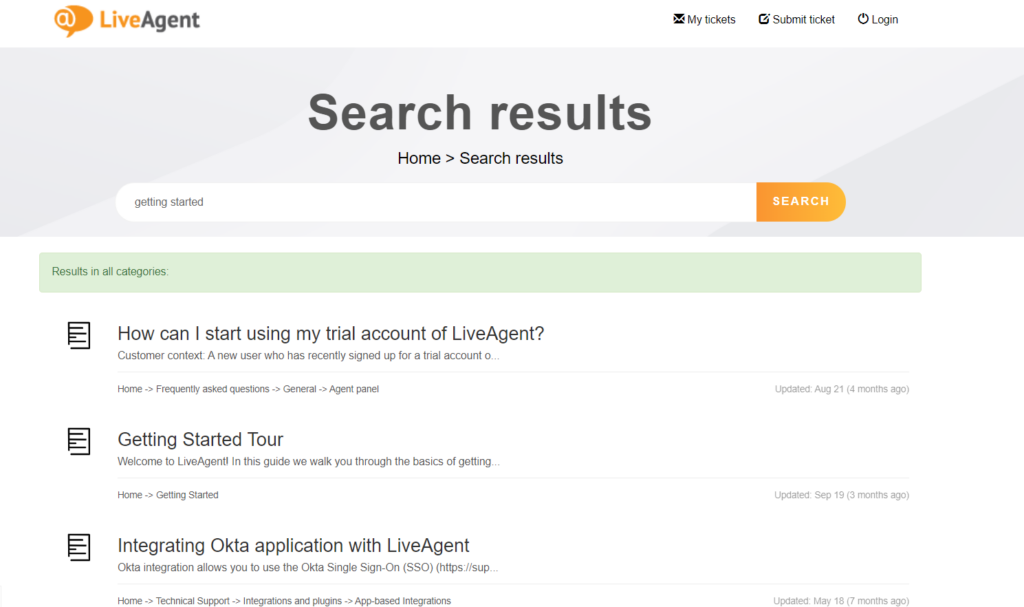
Another advantage is maintaining a separate knowledge base keeps customer support available even during system outages. This ensures businesses can communicate important information to customers effectively.
Here are some categories to consider for your knowledge base content:
- Troubleshooting guides
- Interactive guides
- Video tutorials
- Step-by-step instructions
By investing in a well-developed knowledge base, SaaS providers can enhance user experience, reduce costs, and support customer satisfaction.
| Software | Pricing | Top Features | Free Trial |
|---|---|---|---|
| LiveAgent | Starts at $15/agent | Robust editor, multi-branding | Yes |
| Zendesk | Starting at $49/user | AI-powered search, analytics | Yes |
| Freshdesk | Free, then $15/agent | Self-service portal, automation | Yes |
| Helpjuice | Starting at $120/month | Full customization, powerful search | Yes |
| Document360 | Starts at $99/month | Advanced analytics, version control | Yes |
LiveAgent

LiveAgent is a leading customer support system with over 100 million users worldwide. It stands out for its versatility and customization options, especially in its knowledge base features. Businesses can easily tailor the appearance of their knowledge base to align with their brand, enhancing the user experience.
One of LiveAgent’s standout features is its multi-language support. This ensures that businesses can cater to a global audience, providing flexibility and accessibility. Additionally, LiveAgent’s integration capabilities allow seamless connections with other tools, enhancing its functionality even further.
A key focus for LiveAgent is self-service. It provides customers with easy access to find answers without needing to contact support agents. This improves customer satisfaction and reduces the workload on support teams.
Pricing
- Small plan: $15/month per agent
- Medium plan: $29/month per agent
- Large plan: $49/month per agent
- Enterprise plan: $69/month per agent
LiveAgent is an excellent choice for businesses looking for a comprehensive and customizable knowledge base solution. Its robust features make it a standout option in the SaaS knowledge base software market.
Ready to become a knowledge ninja?
Try LiveAgent's knowledge base software today and turn your customer support into a smooth sail!
Helpjuice
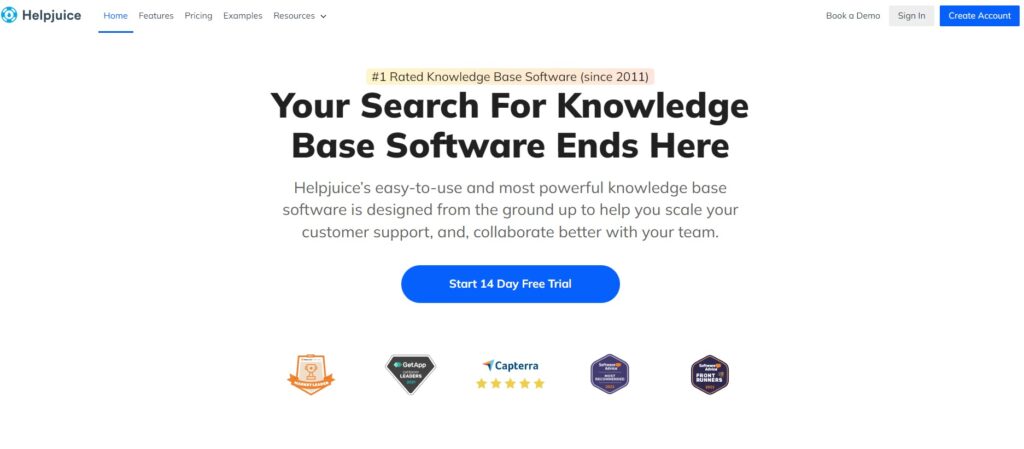
Helpjuice is a top-tier knowledge management software designed to create user-friendly and customizable knowledge bases. Ideal for support articles, FAQs, and guides, it enhances user experience with powerful search features. This allows users to locate information swiftly.
Helpjuice stands out with its robust analytics and reporting tools. These features help track the effectiveness and usage of the knowledge bases. Teams benefit from its extensive collaboration capabilities. Users can co-edit content, comment on articles, and monitor updates in real-time. This makes Helpjuice especially useful for SaaS companies with frequently changing products.
The platform includes a WYSIWYG editor, which simplifies article creation. It supports content import from Word or Google Docs, maintaining the original formatting. Helpjuice also integrates with popular software like Slack, Google Chrome, Zendesk, and Salesforce. This integration capability makes it a comprehensive solution for developing effective knowledge bases.
Pricing
- Starter: $120 per month
- Run-Up: $200 per month
- Premium Limited: $289 per month
- Premium Unlimited: $499 per month
Helpjuice provides a complete solution for managing knowledge bases, ensuring customer satisfaction, and improving team productivity.
Zendesk Guide
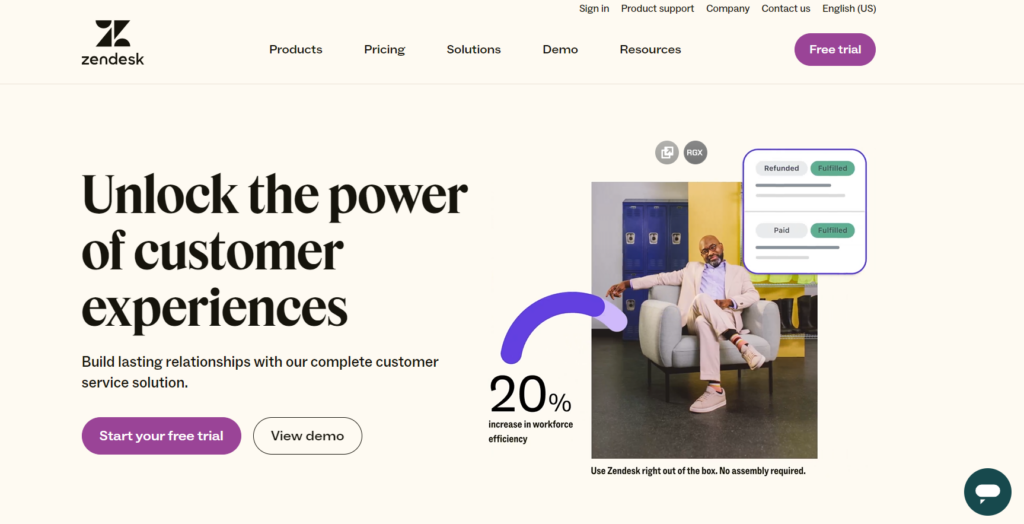
Zendesk Guide is a powerful knowledge management tool that helps organizations create a centralized knowledge base. It offers help articles, FAQs, and community forums to streamline support operations. By integrating seamlessly with other Zendesk customer support tools, Zendesk Guide enhances the customer experience and makes information accessible.
One of its standout features is the analytics and reporting tools. These tools allow businesses to monitor how users interact with the knowledge base, measuring its effectiveness. This data helps in refining content for better customer satisfaction.
Customization is another strength of Zendesk Guide. It allows you to create well-formatted articles for both customers and support agents, which aids in providing quick solutions to common questions. Furthermore, its user forums tool facilitates community building, which can reduce the volume of direct support requests.
Key features:
- Centralized knowledge base with FAQs and articles
- Seamless integration with Zendesk tools
- Analytics and reporting for usage tracking
- Customizable article formats
- User forums for community interaction
Pricing
- Suite Team: $55 per agent/month (billed annually)
- Suite Growth: $89 per agent/month (billed annually)
- Suite Professional: $115 per agent/month (billed annually)
- Suite Enterprise: Custom pricing; contact Zendesk for details
With Zendesk Guide, your organization can provide an effective knowledge base that improves the overall user experience.
Knowledgebase.com
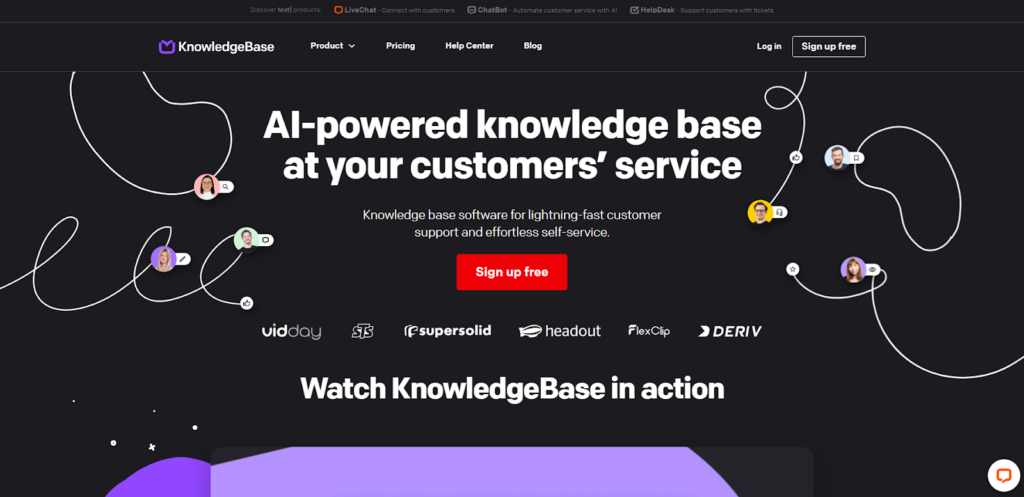
KnowledgeBase by LiveChat, Inc. is an excellent solution for those looking to create efficient internal or external knowledge bases. The platform allows customization with your company’s branding elements, such as logos and colors, ensuring consistency with your corporate identity.
A standout feature of KnowledgeBase is its support for article ratings, coupled with reporting dashboards. These tools help teams analyze the performance of content, optimizing the effectiveness of your knowledge base. Furthermore, mobile-friendly capabilities ensure accessibility across devices, while integration with Google Analytics lets users track customer engagement effectively.
One of the most innovative aspects of KnowledgeBase is its seamless integration with LiveChat. This integration places a widget within chat windows, enabling customers to explore support materials without leaving the chat. This improves the customer experience by offering quick self-service resources.
Pricing
- Standard Plan – $59 per month
- Includes all features Annual Plan Discount – Save $120
- Additional Knowledge Bases – $21.99 each
A well-managed knowledge base reduces operational costs by delivering faster and more consistent responses to customer inquiries. This allows support teams to concentrate on more complex issues. The solution is thus a valuable addition for businesses aiming to enhance customer satisfaction and operational efficiency.
HubSpot Knowledge Base
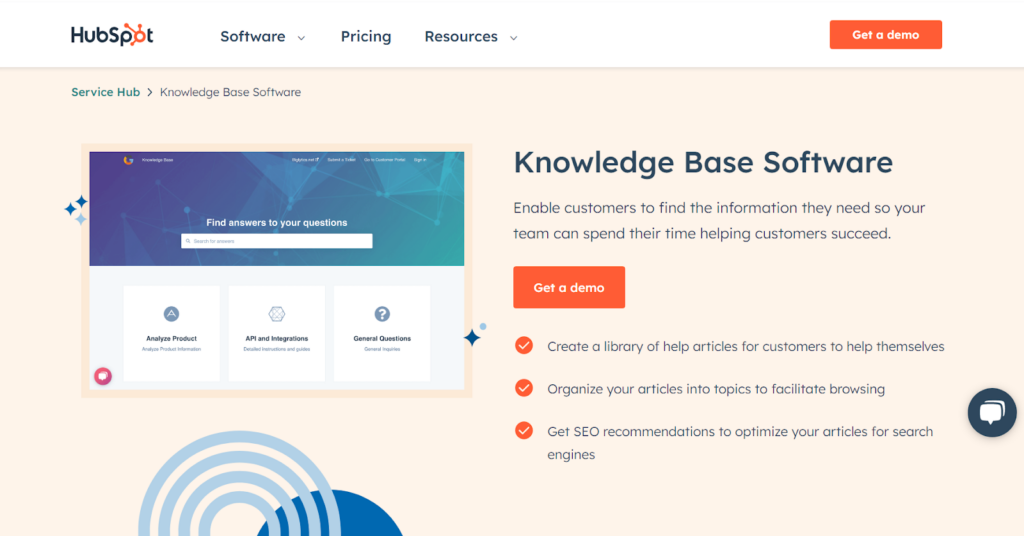
HubSpot’s knowledge base solution is integrated with its all-in-one CRM platform. This makes it a top choice for SaaS companies looking to streamline customer service, sales, and marketing operations. One key feature is its built-in reporting tools. They provide valuable insights into knowledge base performance, including article views and customer satisfaction ratings.
HubSpot syncs its knowledge base with the HubSpot CRM, ensuring all teams can access critical customer context. This integration enhances the overall customer experience. Users can create articles and FAQs to empower customers to resolve their issues independently. Plus, they can track performance and optimize content based on user feedback.
The platform also offers a customizable design and multi-language support. This makes it easy for businesses to cater to diverse customer needs and preferences. Official pricing info ensures you understand the cost of these benefits upfront.
HubSpot Knowledge Base Features:
- CRM integration
- Built-in reporting
- Article creation
- Multi-language support
Pricing
- Free Plan: $0/month per user
- Starter Plan: Starts at $20/month per seat
- Professional Plan: Starts at $100/month per seat
- Enterprise Plan: Starts at $150/month per seat
Freshdesk
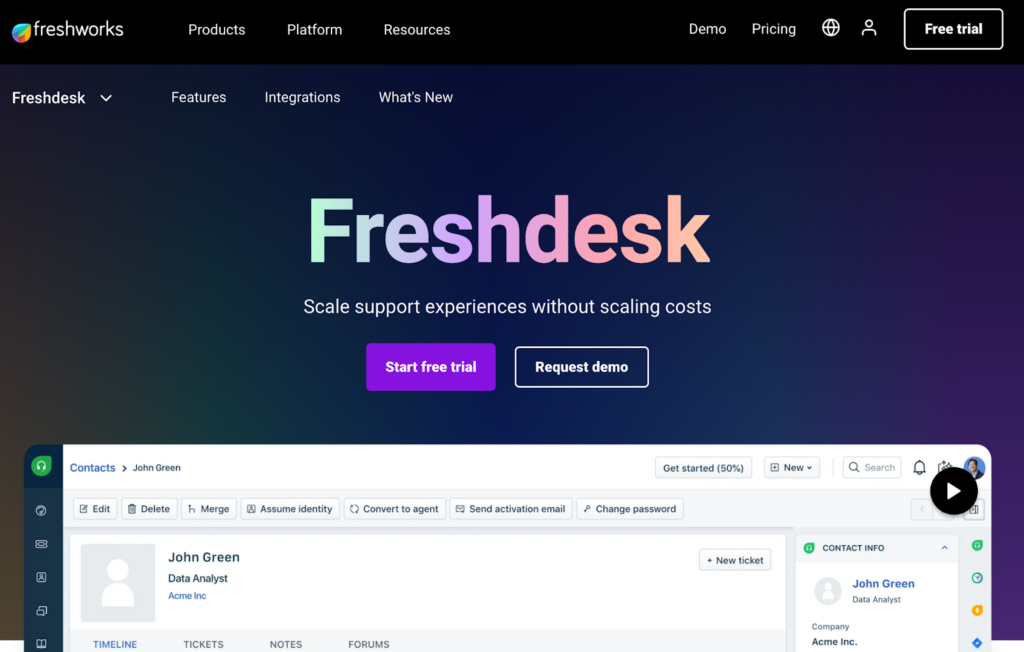
Freshdesk is a versatile self-service knowledge base platform. It empowers businesses to create, manage, and deliver support content, such as help articles and FAQs. This allows customers to independently troubleshoot common issues. Internally, companies can organize information like onboarding resources and company policies.
Key features of Freshdesk include a robust ticketing system and multi-channel support. Businesses can communicate with customers via email, phone, live chat, and social media. Freshdesk also boosts team productivity through gamification and automation tools.
Freshdesk fosters a self-service culture with community forums and knowledge bases. These tools ensure that both customers and team members can easily find the information they need.
For businesses new to knowledge management, Freshdesk offers a free plan. This plan includes essential features like knowledge base building and ticketing.
Here’s a list of knowledge base Freshdesk features:
- Help article creation
- User-friendly interface
- Customizable design
- Email to knowledge base feature
- Categorization and organization
- Internal knowledge base
Pricing
- Free Plan: $0/month per agent
- Growth Plan: $15/agent/month, billed annually
- Pro Plan: $49/agent/month, billed annually
- Enterprise Plan: $79/agent/month, billed annually
Freshdesk is an effective knowledge base solution supporting both customer and internal needs.
Document360
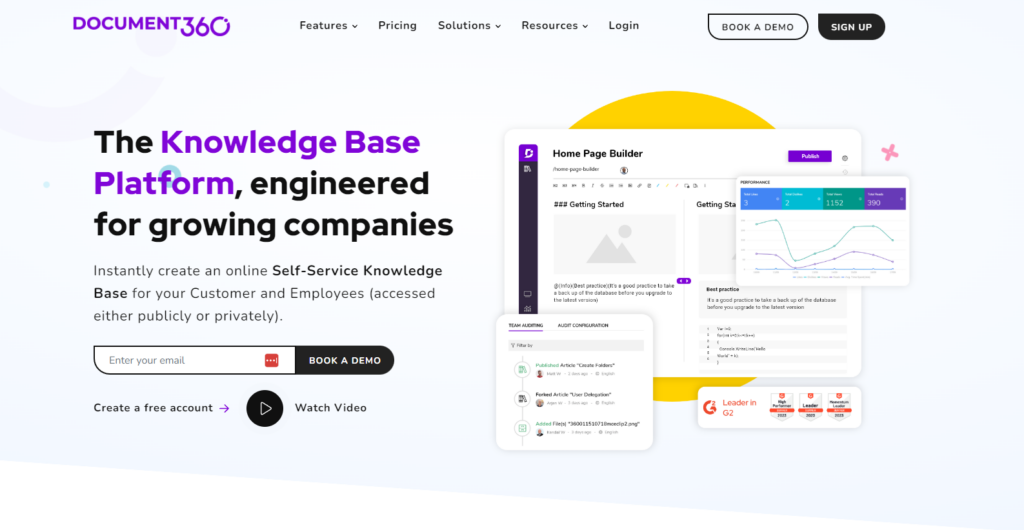
Document360 is a versatile tool for managing knowledge bases. It caters to both internal and external needs. With a user-friendly platform, content authors can easily choose between Markdown or a WYSIWYG editor. This flexibility ensures a smooth knowledge base experience.
Key features of Document360 include version control, custom branding, and comprehensive analytics. These help organizations keep their knowledge bases current and tailored to their brand. Users can also benefit from detailed feedback tools. A highlight is the drag-and-drop functionality, allowing for better content structure up to six levels deep.
For startups or small teams, Document360 offers a generous forever-free plan. This plan allows the creation of up to 250 articles at no cost, making it accessible for those on a budget.
For the most current and detailed information, please refer to Document360’s official pricing page.
Knowmax
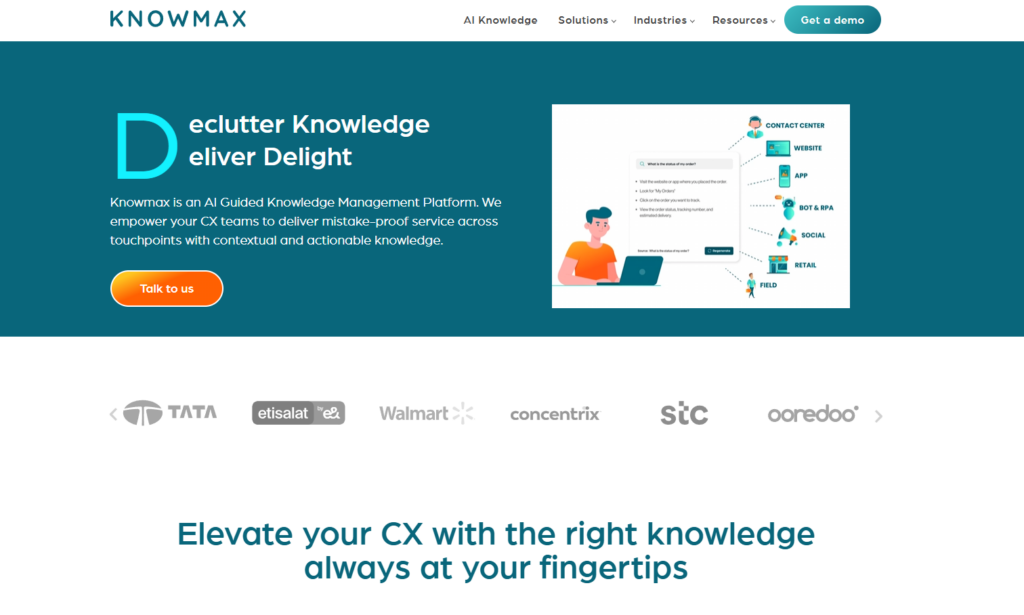
Knowmax is a CX-first Knowledge Management Platform designed to centralize organizational knowledge. It uses AI to assist both agents and customers with actionable insights, including next-best actions and visual guides. This platform empowers knowledge authors to transform static articles into interactive workflows and generate summaries of existing content.
One standout feature of Knowmax is its built-in analytics. These analytics provide a detailed look at knowledge health, tool activity, and search trends. By offering these insights, Knowmax helps organizations enhance customer satisfaction. It seamlessly integrates with existing tools like CRM and chat systems, making relevant knowledge easily accessible.
Key benefits of Knowmax include:
- AI-powered features for both agents and customers
- Interactive workflows from static articles
- Detailed analytics for knowledge management
- Seamless integration with CRM and other tools
Pricing
Pricing for Knowmax is available on request, as it varies based on organization size and specific needs. This flexibility ensures that businesses of any size can find a suitable package.
Knowmax is an effective tool for improving customer experiences through better knowledge management and self-service resources.
Bloomfire
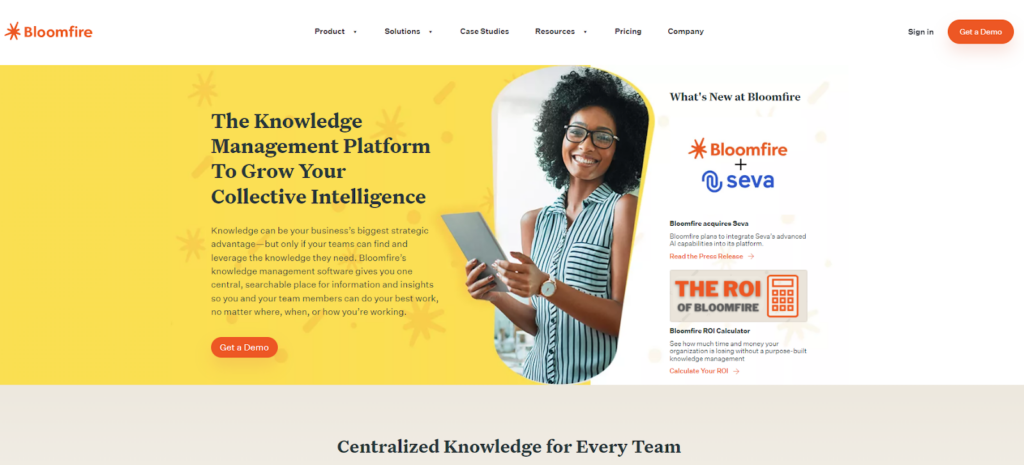
Bloomfire is a SaaS knowledge management platform that excels in creating a rich resource hub. Its prominent search features and structured layout enhance customer success. With Bloomfire, users can filter relevant articles by publication date and content type, fostering knowledge sharing and engagement.
One standout feature is Bloomfire’s search functionality. It deeply indexes every file, including videos, ensuring employees can quickly access relevant knowledge. Personalized feeds present users with content they might not have been actively searching for, adding value to their experience.
Bloomfire also encourages community-based knowledge management. Employees can ask and answer questions within the platform, boosting engagement. This community aspect is vital for fostering a culture of continuous learning.
Here’s a look at Bloomfire’s features:
- AI-Powered Search & Discovery
- AI Author Assist
- Content & Document Management
- Advanced Reporting & Analytics
- Access Management
- Moderation & Compliance
- Homepage Builder
- Data Security
Pricing
Official pricing details can be found on the Bloomfire website for those interested in leveraging this platform.
These features make Bloomfire a strong choice for organizations looking to boost employee engagement and streamline knowledge access.
ServiceNow Knowledge Management

ServiceNow Knowledge Management is a powerful solution for creating and managing a SaaS knowledge base. This software helps organizations build self-serve online libraries that streamline information access and management. Key features include document embedding, rich media support, and an advanced search functionality that improves the user experience.
Customers prefer self-service options, and with ServiceNow’s comprehensive tools, businesses can reduce operational costs and enhance customer satisfaction. By utilizing an effective knowledge base, customers can solve simpler issues on their own, which reduces the load on customer support teams and lowers support ticket volumes.
In essence, ServiceNow Knowledge Management allows organizations to optimize information collection and retrieval, empowering users with swift answers to common questions. This leads to less direct contact for support and a stronger focus on customer success.
Key Features:
- Enhanced search capabilities
- Rich media support
- Document embedding
Pricing
While the official pricing for ServiceNow Knowledge Management isn’t publicly listed, organizations can contact ServiceNow for tailored solutions and pricing plans. This ensures the solutions meet their specific needs while offering robust knowledge base capabilities.
Practical insights for choosing the right knowledge base software
Choosing the right SaaS knowledge base software is crucial for improving customer experience and reducing support costs. A well-managed knowledge base allows customers to resolve common questions quickly, freeing up your customer support team for more complex issues.
Key Features to Look For:
- Easy Editing: A WYSIWYG editor helps create content without technical skills.
- Customization: Consistency in branding enhances the user experience.
- Accessibility: Access solutions anywhere, reducing the need for in-house support.
LiveAgent stands out as the best option, offering a user-friendly platform with strong customization and editing tools.
Here’s a brief comparison of the top five SaaS knowledge base software:
| Software | Pricing | Top Features | Free Trial |
|---|---|---|---|
| LiveAgent | Starts at $15/agent | Robust editor, multi-branding | Yes |
| Zendesk | Starting at $49/user | AI-powered search, analytics | Yes |
| Freshdesk | Free, then $15/agent | Self-service portal, automation | Yes |
| Helpjuice | Starting at $120/month | Full customization, powerful search | Yes |
| Document360 | Starts at $99/month | Advanced analytics, version control | Yes |
By investing in a comprehensive knowledge base, you ensure that both employees and customers have easy access to vital information, leading to increased customer satisfaction and operational efficiency.
5 SaaS knowledge base examples: Learning from the best
Learning from successful implementations of a knowledge base is like learning to cook from a master chef. Their experience can serve as a guideline on the path to success.
As we’ve mentioned, studying our successful counterparts provides a roadmap for our own success. By learning from successful implementations, we can identify the strategies, tools, and processes that have proven effective. This can significantly reduce the time and resources spent on trial and error, and increase the likelihood of success in one’s own implementation.
Secondly, it helps to avoid potential pitfalls. Every implementation has its challenges and obstacles. By learning from those who have successfully navigated these issues, we can anticipate and prepare for these challenges, thereby minimizing the risk of failure.
Furthermore, it fosters innovation and improvement. By understanding what has worked well in the past, we can build upon these successes to create even more effective and efficient knowledge base strategies.
Lastly, this approach promotes a culture of knowledge-sharing and collaboration. By learning from others’ successes, one acknowledges the value of collective wisdom and experience. This can foster a more collaborative and supportive environment, where everyone is encouraged to share their knowledge and learn from each other.
Now, let’s look at five SaaS companies that have mastered the art of knowledge sharing.
1. Slack

Slack’s knowledge base is a comprehensive resource that provides users with detailed information and guidance on how to use the platform effectively. It is designed to help users understand the platform’s features, troubleshoot issues, and maximize their productivity. The knowledge base is organized into different categories, making it easy for users to find the information they need. It includes articles, guides, tutorials, and FAQs, all aimed at helping users navigate the platform and utilize its features to the fullest.
Slack’s knowledge base is constantly updated with new content to reflect the latest features and updates of the platform. This ensures that users always have access to the most current and accurate information. Whether you’re a new user trying to understand the basics, or an experienced user looking to explore advanced features, Slack’s knowledge base is a valuable resource for enhancing your experience with the platform.

2. Mailchimp

Mailchimp’s knowledge base is a comprehensive resource center that provides users with detailed guides, tutorials, and tips on how to use Mailchimp’s various features and services. It covers a wide range of topics, from getting started with Mailchimp to creating and managing email campaigns, to analyzing and improving your results. The Knowledge Base is designed to help users understand and maximize the potential of Mailchimp’s platform, whether they are beginners or seasoned users.
A well-loved feature of Mailchimp’s knowledge base is its search functionality. Users can simply type in a keyword or phrase related to their query, and the knowledge base will provide a list of relevant articles and guides. You can even filter the type of content you want to study. This feature saves users time and effort in finding the information they need. The knowledge base is also regularly updated to ensure that the information provided is current and accurate.
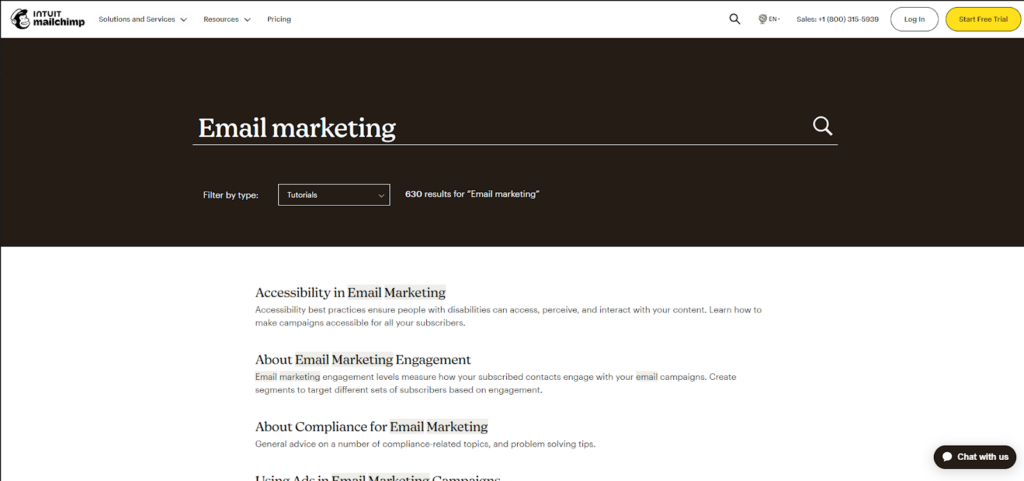
3. LiveAgent
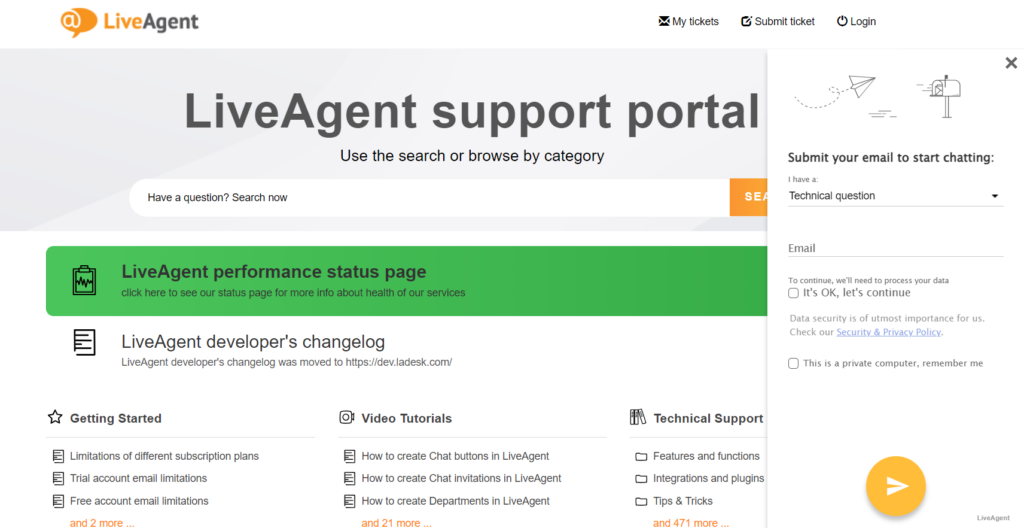
LiveAgent’s knowledge base is a comprehensive, user-friendly platform designed to provide customers with instant access to solutions and answers to their queries, enhancing their overall experience. The knowledge base is an integral part of LiveAgent’s customer service software, which is aimed at improving customer support efficiency and effectiveness.
The knowledge base is not just a tool for customers, but also for the support team. It allows them to easily access and share information, reducing the time spent on resolving customer queries.
Although LiveAgent’s knowledge base software is packed with various features and functionalities, the one that stands out is its multilingual capability. Supporting 43 languages, this feature allows businesses to cater to a global audience by providing support in multiple languages. It enables customers from different regions to access and understand the information in their native language, enhancing their user experience and satisfaction.
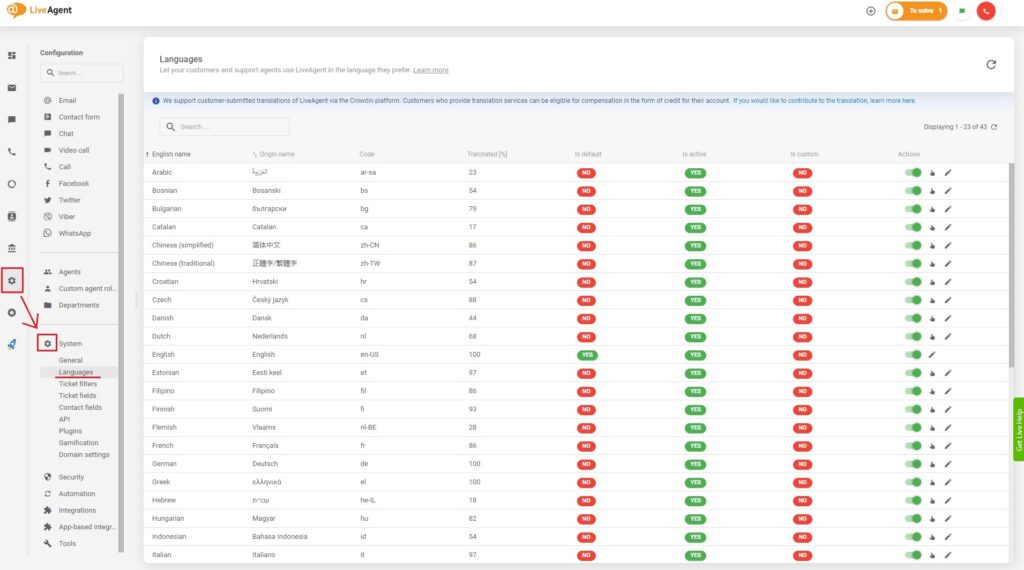
4. Dropbox
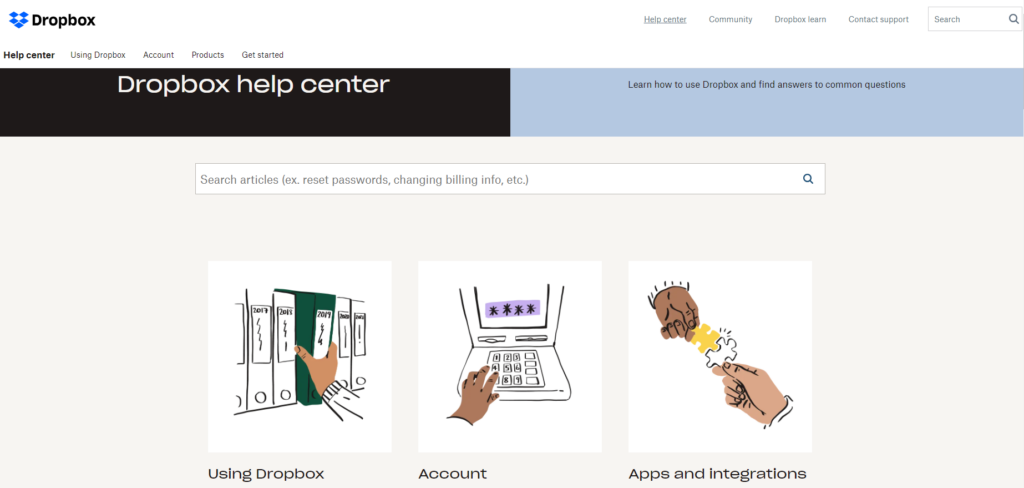
Drobbox’s Help Center is a comprehensive resource that provides users with a wealth of information about the platform. It includes detailed guides, tutorials, FAQs, and troubleshooting tips to help users navigate and utilize Dropbox effectively. It covers a wide range of topics, from basic features and functionalities to advanced settings and configurations.
A standout part of the Dropbox Knowledge Base is its Community Posts section. This is a dynamic, user-driven forum where Dropbox users from around the world can share their experiences, insights, and solutions. There, users can ask questions, discuss issues, and learn from each other. The community posts are not only a great source of practical, real-world advice, but also a testament to the active, engaged, and supportive user community that Dropbox has cultivated.
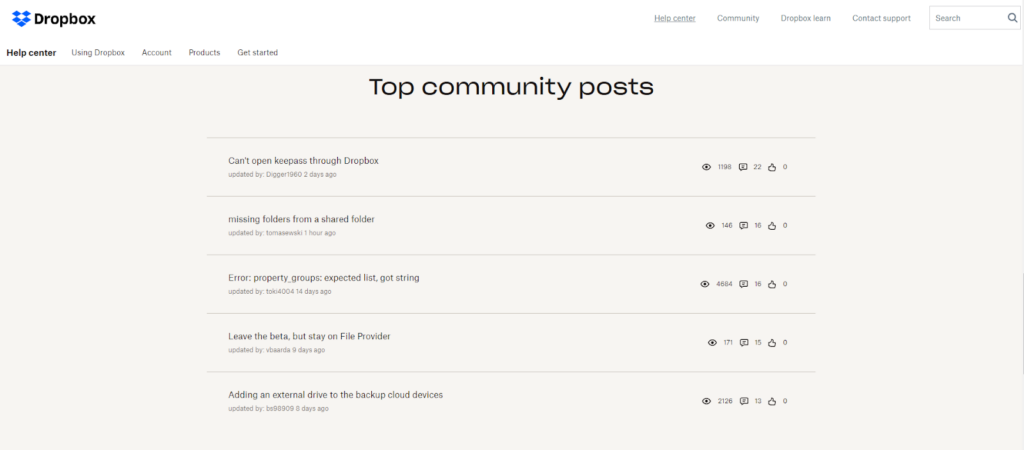
5. Spotify

Spotify’s knowledge base, also known as Spotify Support or Spotify Community, is a comprehensive resource that provides users with a wide range of information about the music streaming platform. It includes detailed guides, FAQs, troubleshooting tips, and community discussions to help users understand and navigate the platform better.
One of the most impressive features of Spotify’s knowledge base is its community-driven aspect. Users can not only find solutions to their problems but also contribute their own insights and experiences to help others. This creates a dynamic and interactive learning environment where users can learn from each other, making the knowledge base a constantly evolving resource.
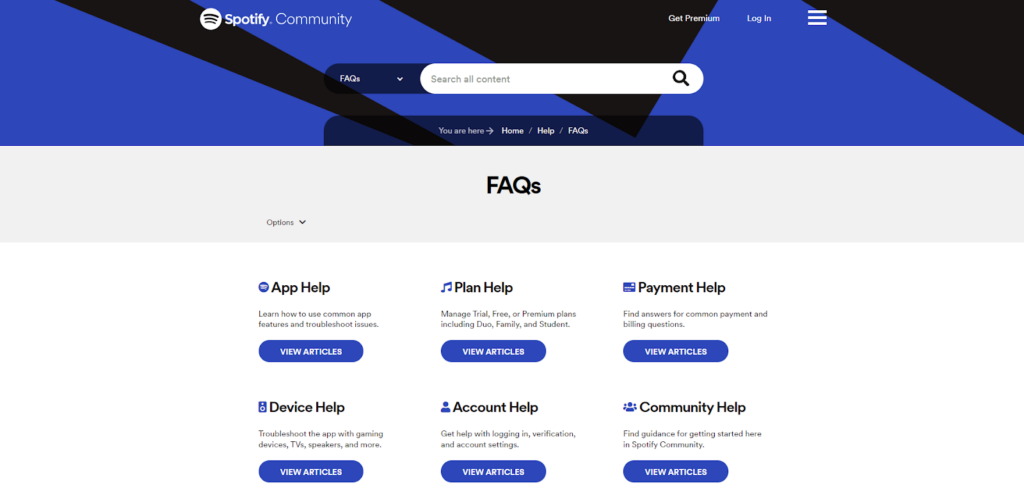
What should you include in your SaaS knowledge base?
What type of data should fill out your SaaS knowledge base? Let’s find out.
1. Product documentation
This is a crucial data type for both customers and internal teams. It includes detailed information about the product, its features, how to use it, and troubleshooting guides.
For customers, it helps them understand the product and solve minor issues independently. For internal teams, it serves as a reference point for understanding the product’s functionalities and addressing customer queries. An example would be a comprehensive user manual or a FAQ section on the company’s website or in an internal knowledge base.
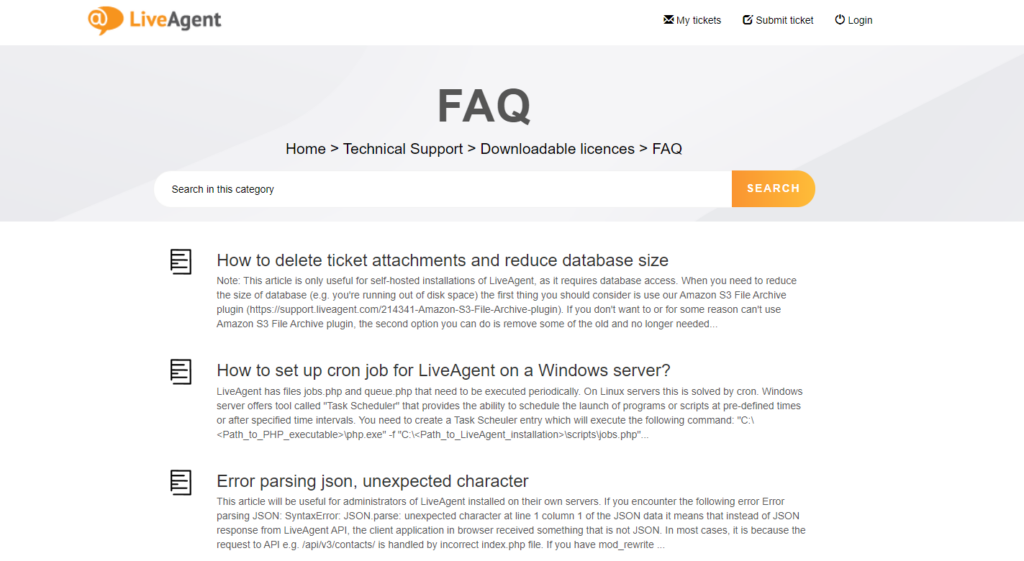
2. Training materials
This data type is primarily useful for internal teams. It includes resources like video tutorials, webinars, and guides that help the team understand the product and its updates better. An example would be a series of training videos on a company’s intranet.
3. Customer feedback and reviews
Mostly beneficial for internal teams, this data type includes customer reviews, feedback, and suggestions about the product. This data helps the team understand customer needs, preferences, and pain points, which can guide product development and customer service. An example would be a feedback forum or a customer satisfaction survey.
4. Case studies and success stories
This type of information is useful for customers, especially potential ones. It includes real-life examples of how the product has helped other customers or businesses. This data can help potential customers understand the product’s value and how it can solve their problems. An example would be a collection of case studies on the company’s website.
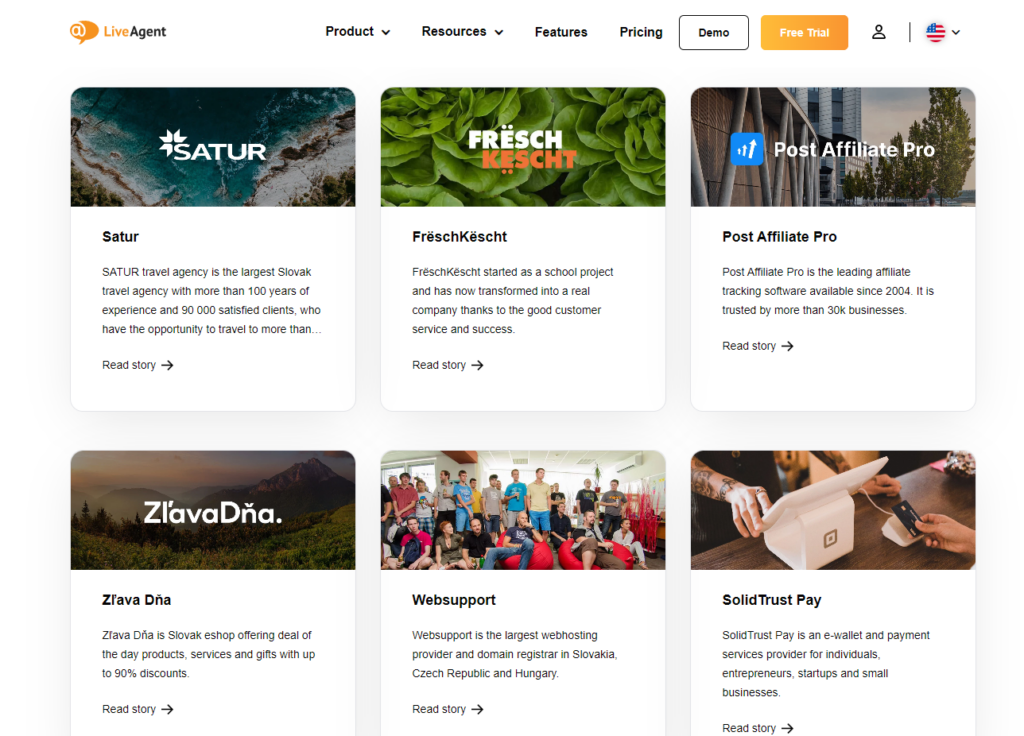
5. Industry news and updates
This data type is beneficial for both customers and internal teams. It includes news about the industry, market trends, and updates about the company and its products. For customers, it helps them stay informed about the product and the industry. For internal teams, it helps them stay updated about the market and plan their strategies accordingly. An example would be a blog or a newsletter.

6. Policies and procedures
Primarily useful for internal teams, this type of data includes information about the company’s policies, procedures, and best practices. This data helps the team understand their roles, responsibilities, and the company’s expectations. An example would be a company handbook or a policy manual.
7. Customer data and analytics
This data type is beneficial for teams and departments in a SaaS company. It includes data about customer behavior, usage patterns, and analytics. This data helps the team understand how customers are using the product, which can guide product development and customer service. An example would be a customer analytics dashboard.
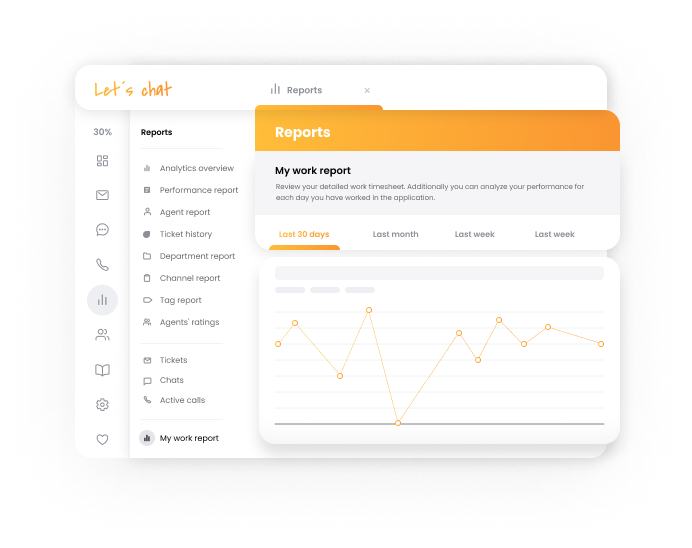
Why invest in a SaaS knowledge base, and what is the ROI?
Did you know that, according to our data, the resolution rate for customer portals is a whopping 95%?
It’s no doubt that implementing a knowledge base is a strategic move for businesses that aim to improve customer service, reduce support costs, and enhance operational efficiency. The return on investment (ROI) can be substantial, as it not only saves time and resources but also improves customer satisfaction and loyalty.
Let’s consider two scenarios to illustrate this point:
Scenario 1: The elusive software feature
John, a freelance graphic designer, has recently purchased a new graphic design software. He’s excited to use it, but he’s been having trouble with a particular feature. He’s spent hours searching through the software’s help center, trying to find a solution. He’s read through countless articles and forum threads, but none of them seem to address his specific issue.
Feeling frustrated, he decides to contact the software’s customer support. He waits on hold for nearly an hour before he’s finally connected with a representative. The representative is friendly, but they’re also unable to provide a solution. They promise to escalate the issue to their technical team and get back to him within a few days.
John is left feeling frustrated and helpless. He’s wasted an entire day trying to solve this issue, and he’s no closer to a solution than he was when he started. He’s unable to work on his projects, and he’s starting to regret his decision to purchase this software.
Scenario 2: The instant solution
Sarah, a small business owner, has just signed up for a new email marketing service. She’s eager to start sending out newsletters to her customers, but she’s not sure how to import her contact list into the new system.
She goes to the service’s help center and types in “import contacts”. The first article that comes up is a step-by-step guide on how to import contacts from various sources. The guide is clear and easy to understand, with screenshots and detailed instructions.
Within minutes, Sarah has successfully imported her contact list. She’s able to start creating her first newsletter right away. She’s impressed with how easy it was to find the information she needed, and she feels confident that she’ll be able to handle any other issues that might come up.
She’s excited to explore more features of her new email marketing service, and she’s grateful for the time she’s saved by finding the answer so quickly.
These two scenarios clearly highlight the importance of a reliable and comprehensive knowledge base for any software or service. In the first scenario, John’s experience was frustrating and time-consuming due to the lack of a helpful knowledge base. His productivity was affected, and his perception of the software was negatively impacted.
On the other hand, Sarah’s experience was smooth and efficient. The presence of a well-structured knowledge base allowed her to quickly find the information she needed, saving her time and enabling her to use the service effectively. This not only boosted her confidence in using the new service but also positively influenced her overall perception of the service.
These examples underline the fact that a well-maintained knowledge base can significantly enhance user experience, increase productivity, and foster customer satisfaction. It’s a critical resource that empowers users to solve issues independently, reducing the need for customer support intervention.
To elaborate on this point, LiveAgent’s knowledge base and community forums could have significantly improved John’s situation. The knowledge base, with its easy-to-navigate interface, comprehensive articles, and robust search functionality could have provided John with the solution he needed. The frequently updated and reliable community forums, on the other hand, could have allowed him to connect with other users who might have encountered and solved the same issue. These features not only provide immediate solutions but also foster a sense of community among users.
Conclusion
Navigating the intricacies of knowledge management in SaaS requires a reliable compass: a platform that champions integration, real-time updates, and a focus on the user. Platforms like LiveAgent and Helpjuice have set benchmarks in this realm, facilitating effortless access to critical information for customers and employees alike.
The potency of a robust knowledge base cannot be overstated, given its role in amplifying user satisfaction and streamlining operations. As you evaluate your options, we invite you to experience firsthand the capabilities of our platform. Take advantage of our free 30-day trial, and empower your business with the tools it truly deserves.
Ready to become a knowledge ninja?
Try LiveAgent's knowledge base software today and turn your customer support into a smooth sail!
Frequently Asked Questions
What is the estimated time required for setting up and deploying a SaaS knowledge base platform?
The estimated time required for setting up and deploying a SaaS knowledge base platform can vary greatly depending on the complexity of the system, the amount of data to be migrated, and the specific needs of the business. However, generally, it shouldn’t take more than 8 weeks to set up the knowledge base and fill it with content.
How can having a SaaS knowledge base platform contribute to reducing support tickets?
Implementing a SaaS knowledge base generally comes with a support ticket reduction as a by-product. It has customers with self-service resources to solve their issues. Furthermore, allows customers to access information and find solutions to their problems without needing to contact support. This not only reduces the workload for the support team but also enhances customer satisfaction as they can resolve their issues faster.
How do I train my team effectively in using a SaaS knowledge base?
You can start by providing comprehensive training sessions that cover all the features and functionalities of the software. Encourage hands-on practice during these sessions to ensure they understand how to use the system. Additionally, provide continuous support and resources for further learning, such as user manuals, video tutorials, and a dedicated point of contact for any queries or issues.
Can a SaaS knowledge base help in collecting customer feedback and insights?
Yes, it certainly can. A SaaS knowledge base allows customers to leave comments, suggestions, and ratings on articles or products. Additionally, it can track user behavior and interactions, providing valuable data on customer preferences and needs.
How do SaaS knowledge base platforms integrate with other tools and software used by businesses?
Most often, SaaS knowledge base platforms integrate with third-party applications through APIs (Application Programming Interfaces) and plugins. These allow for seamless data exchange and functionality between the knowledge base platform and other systems. For example, LiveAgent integrates over 220 applications, including Shopify, Slack, Asana, and much more.
Share this article
Provide excellent customer service
Discover unparalleled customer support with LiveAgent's all-in-one software. Benefit from 24/7 service, a free trial without a credit card, and seamless integration across 130+ ticketing features. Enhance your business with fast setup, AI assistance, live chat, and more. Choose LiveAgent for exceptional service and satisfied customers.
Elevating customer support quality with AI: tools, techniques & best practices
Elevate customer support with LiveAgent’s AI tools—deliver faster, clearer, and more consistent service. Try a 30-day free trial!

 Български
Български  Čeština
Čeština  Dansk
Dansk  Deutsch
Deutsch  Eesti
Eesti  Español
Español  Français
Français  Ελληνικα
Ελληνικα  Hrvatski
Hrvatski  Italiano
Italiano  Latviešu
Latviešu  Lietuviškai
Lietuviškai  Magyar
Magyar  Nederlands
Nederlands  Norsk bokmål
Norsk bokmål  Polski
Polski  Română
Română  Русский
Русский  Slovenčina
Slovenčina  Slovenščina
Slovenščina  简体中文
简体中文  Tagalog
Tagalog  Tiếng Việt
Tiếng Việt  العربية
العربية  Português
Português 

